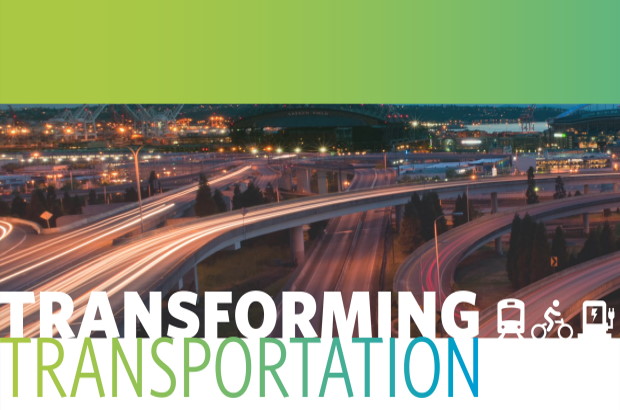About our Transforming Transportation blog series: Part 1 will summarize our research findings on decarbonizing transportation in Washington and Oregon by describing two pathways for cutting pollution. Click here for more details about this research, including our full whitepaper and summary report. Upcoming parts of this blog series will describe how we can meet our clean electricity needs and outline additional conclusions from this body of work.
Transportation is the largest source of our climate pollution in the Pacific Northwest. Air pollution from this sector impacts our health, disproportionately harming low-income and BIPOC (Black, Indigenous, and people of color) communities. And as we have seen from recent wildfires, heatwaves, and flooding, it is critical that we cut these climate emissions in order to maintain a stable climate.
Our region has made progress in accelerating the transition away from fossil fueled transportation. In May, Washington joined Oregon by enacting a Clean Fuel Standard. At the end of November, the Washington Department of Ecology released rules requiring increasing sales of zero emissions vehicles large and small, following Oregon’s adoption of clean truck rules earlier in the month. These are significant steps forward, but more must be done to clean up our transportation and meet our climate goals.
How do different options to cut climate pollution impact our health, safety, spending, transportation infrastructure, and electricity grid? How do impacts vary for different areas and communities most burdened by transportation pollution?
With new research, Climate Solutions evaluates our options to meet our climate goals in Washington and Oregon, cutting carbon from our transportation system with a focus on two main variables:
1) the speed and level of conversion to electric vehicles, and
2) the amount of vehicle miles traveled (VMT).
We found that the need for a rapid and substantial increase in electric passenger, freight, and transit vehicles is at the core of achieving near-zero carbon emissions by 2050. Electrifying transportation is good for us. We will see improved health and air quality, reduce how much money we spend to get around, and cut our climate pollution. But, when we combine electrification with increasing transit use, biking and walking, and reduced vehicle dependency, we see even more health, safety, and financial benefits.
Scenario 1: An ideal world, Electrification + VMT reduction
In this scenario, we reduced vehicle miles traveled compared to business as usual, modeling impacts as more people switch to transit, walking, biking, or avoiding trips altogether. Specifically we:
- Set Seattle and Portland per capita VMT levels to be about the same as London today (a 47% reduction by 2050, which lower than New York City’s levels);
- Matched VMT per capita in small cities to the New York state average, which is the state with the lowest VMT;
- Reduced freight VMT by 15%.
Overall, this amounts to a VMT reduction of 27% by 2050, compared to business as usual.
In addition, nearly all vehicles must be electric by 2050: 100% of passenger and light duty vehicles, 98% of buses, 93% of medium duty trucks, and 85% of heavy duty trucks.
This combination of electrification and VMT reduction cut carbon pollution to 97% below 2020 levels by 2050. This averts 475 million metric tons of greenhouse gas emissions by 2050, which translates to saving $41 billion in the social cost of carbon compared to business as usual.
In addition to these climate benefits, this scenario includes significant health, safety, and economic benefits. The reduction in tailpipe emissions that comes from reducing VMT and electrifying results in massive health benefits which translate to monetary savings: up to $626 million annually by 2050. These health benefits include fewer hospital admits for respiratory problems, fewer asthma attacks, and fewer days with restricted activity due to pollution impacts. For Black, Indigenous, and people of color in Seattle alone, these health benefits amount to a minimum of $88 million in avoided health costs by 2050 and 176 fewer annual asthma attacks.
We also see an increase in active mobility, with 250,000 more people walking, biking, or using micromobility. In addition to reducing deaths caused by pollution, reducing VMT will also reduce deaths caused by vehicle crashes. Under this scenario, 205 lives will be saved in 2050.
This scenario requires significant public investments, but also leads to personal savings. To support the amount of electrification required to decarbonize in this scenario, we will need 750,000 public chargers. We will also need to significantly invest in transit to help reduce VMT. However, we will need to spend much less on roads due to less use and wear. All together, we see only $200 million more in public spending on roads and transit than business as usual.
Owning an electric vehicle is cheaper than owning a gas-fueled vehicle and reducing the frequency of driving or opting out of owning a vehicle entirely is cheaper yet. Under this scenario, thanks to the combination of electrification and reducing the need to drive, the average person will save around $4,370 annually when compared with business as usual.
Scenario 2: Near-100% electrification
This scenario combines the deep electrification of scenario 1 with no changes to per capita VMT. It achieves our emissions reduction goal, with carbon pollution dropping to 96% below 2020 levels by 2050. This averts 435 million metric tons of greenhouse gas emissions by 2050, which translates to saving $38 billion in the social cost of carbon compared to business as usual. But, by not seizing the opportunity to cut our vehicle reliance sooner, we emit tens of millions of tons more carbon than if we had offered people more options in how they get around.
Reducing tailpipe emissions results in substantial health benefits, and both this scenario and scenario 1 result in similar outcomes by 2050. However, the health savings do not accrue as quickly in this scenario, with $10-$24 million fewer in health-related savings in 2025 due to more miles being traveled by vehicles that are not yet electrified.
Near-term benefits under this scenario are smaller for BIPOC communities and low-income communities as well for the same reason. Health benefits remain, but they are not as significant as in scenario 1.
Because travel patterns are the same as business as usual, we do not see decreases in crash deaths or increases in active mobility under this scenario.
Since electric vehicles are cheaper to fuel than gas-powered vehicles, individuals will save about $1,780 annually compared with the status quo. However, they will not save as much as they would under the scenario where electrification is paired with VMT reductions because fewer people have the option to opt-out of car ownership entirely.
When we combine road, transit, and incremental electricity costs (more on this coming soon in our blog series), this scenario is $1.4 billion more expensive than Scenario 1.
In sum, scenario 2 also presents many benefits: we decarbonize our transportation sector, spend less money on getting around, and see enormous health benefits. However, these benefits are not as significant and accrue more slowly than the previous scenario.
Looking Ahead
It is possible to decarbonize our transportation sector, but we must act quickly by reducing vehicle miles traveled and electrifying all vehicles still on the road. In addition to mitigating the climate crisis, electrifying transportation and reducing VMT will lead to improved equitable outcomes including substantially better health and air quality, and a reduction in how much money we spend to get around compared to business as usual.
While we can meet our decarbonization goals by focusing only on transportation electrification, we see even more holistic health, safety, and economic benefits when paired with increasing transit use, walking, and biking. Thus, we must support an equitable array of bold policies that will support rapid transportation electrification; invest more in transit, active transportation infrastructure, and other ways to reduce vehicle trips; improve our land use policies to make it safer and easier to walk, bike, and use transit to get around; and, integrated into all policy, an emphasis on improved health, safety, and justice.
The sooner we do this, the more quickly we will experience the benefits of a clean, healthy, and just transportation system.
Coming soon in our Transforming Transportation series: a deep dive in how we can effectively and efficiently power our transportation with clean electricity.

